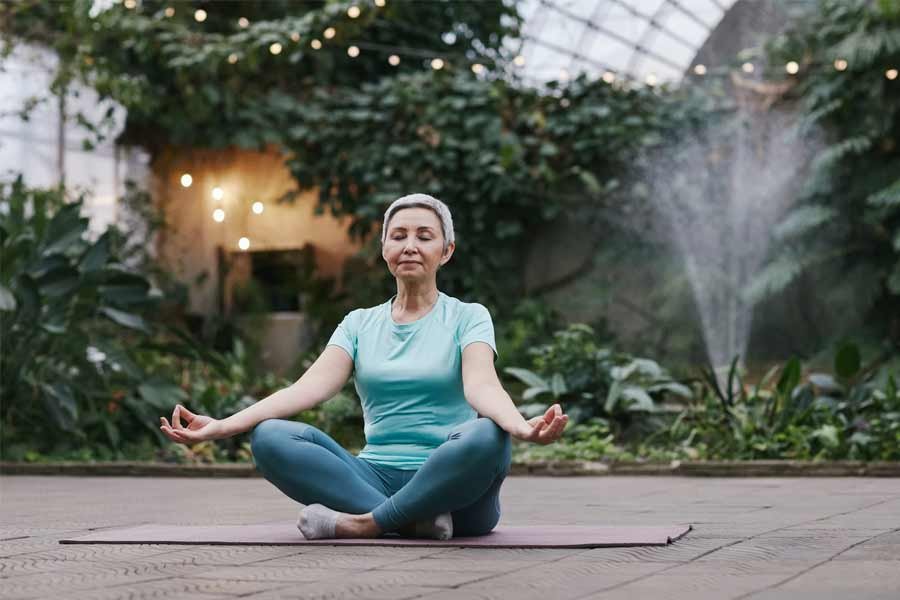Mindfulness is the ability to focus on the present moment. In a busy world full of noisy neighbors, blinking gadgets, and all sorts of other distractions, we often forget to notice the simple things happening all around us. By paying attention to your senses and really appreciating the outside world, you can become a more mindful person. This mindfulness, in turn, will help you reduce stress and enjoy a more relaxing lifestyle.
Group sessions offer great opportunities for meaningful mindfulness exercises. When you have several people together working toward a common goal, you can draw inspiration from each other. You can also take advantage of your numbers to engage in fun group tasks that are impossible to perform alone. Here are eight mindfulness activities that can make group therapy a more mindful experience.
1. Body scan mindfulness exercise
This mindfulness exercise takes into account the simple fact that stress and anxiety present as physical symptoms throughout the body. If you’re not mentally at ease, pesky ailments like headaches and muscle pains are bound to crop up. A body scan won’t eliminate these pain points immediately, but it will allow you to recognize them and gradually overcome them.
To undergo a body scan, you should start by putting yourself in a comfortable position. In a group therapy session, participants are generally encouraged to lie down on their backs. Once you’re as comfortable as you can be, you should take a few deep breaths to put yourself in a meditative state. Start by focusing on your feet, and acknowledge any pain you might feel there. Breathe into the pain and see if it subsides. Then, bring your attention gradually upward across your body, stopping wherever you feel discomfort. Regularly engaging in the body scan exercise should help you reduce stress, manage pain, and reduce insomnia.
2. Five senses mindfulness exercise
One of the best ways to increase your level of mindfulness is by focusing on the environment around you rather than the thoughts and concerns swirling around in your brain. Your five senses are what transmit the outside environment to your consciousness, so you can refine your mind by giving them special attention. The five senses mindfulness exercise trains your mind to really connect with sensory data.
The first step of the exercise is to look around you and identify five things you can see. Then, take a moment to identify four things you can feel. The next step is to pinpoint three things you can hear. After that, sniff around for two things you can smell. The final step, as you’ve probably guessed, is to notice one thing that you can taste. This simple, straightforward exercise is great for unlocking your senses and truly experiencing your environment. When you can successfully focus your mind on the world around you, you can ignore the troublesome thoughts inside your head.
3. Mindful eating exercise
Eating is a truly fascinating activity for our five senses, and yet most people fail to pay attention to everything that's going on. Noticing everything about your food, from its appearance to the way it feels in your mouth, will help you develop a more mindful outlook in general. With mindful eating, the simple act of consuming food becomes a chance to connect with your body and relate to the world around you.
The first step in a mindful eating exercise is to look carefully at the food you’re about to eat. Appreciate its color, size, and shape. Then, close your eyes, take the food in your hand, and explore what it feels like. Next, give the food a hearty smell, noticing the aromas without thinking too much about them. Finally, put the food in your mouth and eat nice and slowly, noticing how the flavor changes as you chew and eventually swallow. Not only is this exercise a great tool for mindfulness, but it will also help you really enjoy your food.
4. Noticing another activity
Humans are inherently social, so it makes sense that we should be mindful toward other people as well as toward inanimate objects. When you look closely at the wonder of another human being, you’ll connect more fully with the world around you.
For the “noticing another” activity, you and a partner will sit facing each other. You’ll proceed to take turns simply stating what it is you like about the other person. There are no rules about the types of observations you can make. From physical attributes to personal qualities, everything is fair game. The point is to really focus on what's good about the other person. Being mindful about another’s positive qualities will give you a more otimistic take on other people, the world, and even yourself.op
5. Mindful listening game
Mindfulness requires focus and attention to sensory detail. To be mindful, you need to tune out certain elements and focus on others. Acquiring this skill requires practice, and a group session is the perfect setting to train your mind and have lots of fun while doing it.
The mindful listening game gives everyone a chance to practice in a light-hearted, enjoyable environment. To start the game, all participants must sit in a circle. One person will make a simple noise, from a clap of the hands to a rhythm patted out on their knees. The next person in the circle must imitate this sound before adding another. You’ll then continue around the circle, each person repeating the string of sounds and adding their own. If someone misses a sound, they’re considered “out,” at which point they’re invited to purposefully distract the players still in the game. The winner is the last person remaining.
6. Progressive muscle relaxation exercise
There are all sorts of ways to use physical movements to increase your sense of mindfulness. Muscle relaxation is a great method for noticing your body while reducing tightness and stress. If you purposely squeeze some part of your body, creating momentary tension, and then release that tension a few seconds later, you’ll help your muscles relax. The progressive muscle relaxation exercise applies this principle to the entire body.
The first step is to place yourself in a comfortable position, either lying down or sitting in a chair. Then, tighten and release your toes to produce the aforementioned sense of relaxation. Move on to complete this same routine in your feet, then your calves, and then your thighs. Continue up your body until you reach your shoulders. By the time you’ve finished your entire body, you should enjoy a general sense of relaxation and ease.
7. Objects in a bag activity
Mindfulness is all about attaching your mind to the world around you through the intentional use of your five senses. Touch in particular is a sense that people often overlook. Our bodies are constantly gathering data about the world through the skin, and yet we often fail to notice. The “objects in a bag” activity is a great way to encourage a conscious focus on the power of touch.
The game itself is remarkably simple. All you need is an opaque bag and a random assortment of objects. Put the objects in the bag, then pass them around so people can guess what’s inside. Everyone should pay close attention to the size, shape, and texture of what they’re feeling. This activity is a fun way to promote the mindful use of the sense of touch.
8. Write it down activity
Writing has long been a recognized method for noticing what’s going on in the world around you. It forces you to gather and explain your thoughts, but it allows you to stay within yourself without getting other people involved. In a group setting, writing down thoughts and observations can help everyone address their inner worlds for a moment.
All you need for the “write it down” activity is a pen and paper. Everyone will start by jotting down a simple set of observations about what is happening in the room around them. Then, you’ll move on to describe the thoughts passing through your mind. From there, take a few minutes to describe the physical sensations you feel in your body. The final step is a bit more meta, calling on participants to write about how they’ve perceived the activity itself. Once everyone has finished, the group members should read their accounts out loud. The reading allows you to see the myriad differences and similarities in people’s perceptions.
Conclusion: Group activities can promote individual mindfulness
When a group therapy session focuses on mindfulness, it gives participants the chance to connect on a deeper level with the world around them. When you focus on sensory details and simply exist in the moment, you give yourself a break from the endless chatter inside your head. Pausing your internal dialogue for a few moments of mindfulness will have considerable effects on your overall well-being, helping you limit stress and gather a sense of inner peace. There are all sorts of group activities that promote mindfulness, from meditative exercises like the body scan to hilarious games like the mindful listening task. When you’re done with these activities, you’re bound to feel more in touch with yourself, your groupmates, and your physical environment.
https://positivepsychology.com/group-mindfulness-activities/




